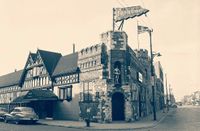Ivanhoe Theater (Chicago)
- Ivanhoe Theater
- 750 W. Wellington Ave., Chicago, IL and
- 3000 Clark St, Chicago, Il (two addresses - one building)
History
When two brothers opened the Ivanhoe as a restaurant in the 1920s, it looked like a castle from Europe’s Middle Ages had been plunked down on the corner of Clark and Wellington.
Inside, patrons could dine and dance in Robin Hood’s Sherwood Forest. The menu specialized in German and European dishes described as “inexpensive but nice.”
The restaurant’s name came from a 19th-century novel set in England in the 12th century: “Ivanhoe: A Romance” by Sir Walter Scott, which one of the owners loved.
A subterranean realm with eerie tunnels led to a rustic bar with wooden tables. There were stalactites and bones embedded in the walls. According to many sources, the joint was a speakeasy during prohibition. And getting there was half the fun.
Patrons would step onto a cramped open-sided elevator. Guests would watch the brick disappear above them as the shaky car descended deep into the earth's bowels — or so it appeared.
Really, the elevator would go down to the basement. The operator shook the car with their legs, and the disappearing walls were thanks to a revolving visual effect.
In 1966 a son of the original owners took over the business and turned it into Dinner theater.
The Ivanhoe was a theater in the round — or rather, a square. The audience was seated on all four sides of the stage, distinguishing it from the more formal velvet curtain downtown theatres.
The Ivanhoe started out staging lighter comedies headlined by well-known TV and movie actors but not exactly A-listers. But things changed when the owner brought in producer/director — George Keathley, who had worked on Broadway, and in regional theatres with, among others, playwright Tennessee Williams.
Keathley shifted the direction to more substantial plays starring prominent stage actors. Rita Moreno was one of the first stars featured under Keathley in Tennessee Williams’s “The Rose Tattoo.”
With Keathley at the helm, the Ivanhoe helped give birth to what would become Chicago’s nationally acclaimed off-Loop and storefront theater scene. Known for being rough around the edges and both entertaining and challenging.
The theater had quite the rage.
Jackie Kennedy’s sister Lee Radizwill made her acting debut at the Ivanhoe in “The Philadelphia Story” at the urging of Truman Capote. Her performance was savaged by the critics and by her co-star.
And that show was followed by Zsa Zsa Gabor in Noel Coward’s “Blithe Spirit”.
Among the most popular shows was a play called “Status Quo Vadis” – a comedy that took on America’s social class structure. However, it was panned when it moved to New York.
However, the theater’s dinner-and-a-show model had mixed results.
Since most diners were also there to see the theatre, the restaurant would clear out when the show started.
This eventually led to the sale of the business to a new producer who just rented out the space to other theatre companies and to concert promoters who brought in acts, including Dolly Parton, Graham Parker, and David Steinberg.
In the 1980s, the theatre was chopped in half, converting it from an arena to an amphitheater and the former restaurant next door became Gold Standard Liquors and Chalet Cheese Shop, which later changed its name to Binny’s, as a nod to owner and founder, Harold Binstein.
When the theatre finally closed for good in 2001, Binny’s expanded to take over the entire space. They retained the castle-like medieval exterior.
And restored the catacombs, using them — before COVID — as an event space for things like wine tastings.
And by the way, The Ivanhoe is not the only Chicago connection for novelist Sir Walter Scott. The suburb of Kenilworth is named after another of Scott’s books.
Closing
Chicago lost one of its most historic off-Loop playhouses on January 27, 2001 when the Ivanhoe Theater was shuttered to expand the neighboring Binny’s liquor store. Built in 1966 as an adjunct to the once-famous Ivanhoe Restaurant (which opened as a speakeasy in the Roaring Twenties), the theater presented such notables as Sandy Dennis, Christopher Walken, James Broderick, Sylvia Sidney, Werner Klemperer, Eileen Herlie, Donald Moffat, Ellen Burstyn, Ethel Waters, and Bruce Boxleitner (who got his start there) among many others in the 1970s. Tennessee Williams’ Outcry received its world premiere at the Ivanhoe, starring Herlie and Moffat.
In the 1980s, the Ivanhoe offered productions by many local companies and producers, among them the Organic Theater Company, Next Theater Company, Steppenwolf Theater Company, Victory Gardens Theater, and Wisdom Bridge theaters with hits such as The Normal Heart, Prelude to a Kiss, In the Belly of the Beast, A Walk in the Woods, and The God of Isaac. More recently, the Ivanhoe housed long-run attractions Late Nite Catechism, the Free Associates, and Hell Cab. The first two shows moved to the Royal George Theater on Halsted Street, while Hell Cab moved to the Theater Building.
The Ivanhoe is now a Binny's liquor store.
Shows of Note
- the Ivanhoe Theater in Chicago hired Andrew Alexander,
- Welcome Home, an original play by Welcome Home, an original play by Edmund Hartmann with Frances Helm and Pernell Roberts in 1972
- Three Hotels (Rachel Silverman Productions, Ivanhoe Theater, Chicago) in 1995
World premiere production: Lookingglass Theatre Co., Chicago. It opened on October 25, 1998 at the Ivanhoe Theater.
- Metamorphoses (play) ↗ World premiere production (Lookingglass Theatre Co.) opened on October 25, 1998.
- The Circus of Miracles (2016) starring Misha Smirnov ↗
External links
Chat rooms • What links here • Copyright info • Contact information • Category:Root
